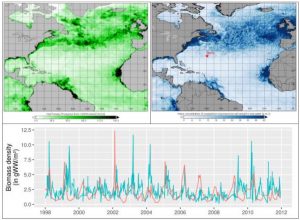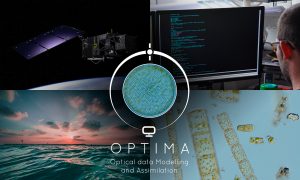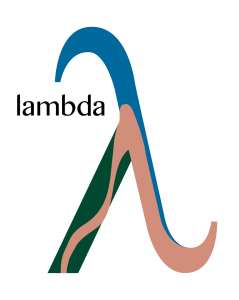MARINE ECOSYSTEM LOW TO MID TROPHIC LEVELS
PI and organization: P. Lehodey (CLS)
Co-Is: I. Senina, O. Titaud, P. Gaspar, B. Calmettes, M. Lalire (all CLS)
Zooplankton and micronekton are key variables to investigate the mechanisms driving movement and migration of oceanic predators, fish recruitment and nutrient cycles in the ocean. They can be used as explanatory variables of species habitat or population dynamics models. The ocean Low and Mid-Trophic Levels (LMTL) functional groups, respectively zooplankton and micronekton (CMEMS GLOBAL_REANALYSIS_BIO_001_033) of the SEAPODYM model have been proved to be a useful and promising product for end users involved in marine resource and ocean ecosystem management (Romagosa et al. 2020; Green et al, in press; Perez Jorge et al., in press).
Results and progress achieved during this CMEMS Service Evolution project LMTL will be rapidly transferred to the production of the next multi-year Zooplankton and Micronekton (LMTL) CMEMS product that will be delivered at the end of this year. This will support the extension of the model domain to higher latitudes and the increase in resolution from 1⁄4°x week to 1/12° x day with a much more realistic mesoscale representation associated to the use of the ocean reanalysis GLORYS12v1 assimilating all available satellite and in situ observations. The improvement is particularly clear in region of complex and shallow topography (e.g., strait of Florida or Gibraltar). A Maximum Likelihood Estimation approach has been used with the COPEPOD database on zooplankton biomass distributions to optimize the model parameter values. The results are validated against the time series of the BATS oceanographic station. The model parameters for the micronekton are also revised according to more detailed biomass estimates compiled and standardised from the literature.
These new variables are proposed particularly to the research community working on marine resources and the conservation of biodiversity. Their feedback will be essential to support the continuous improvement of these products.
Figure. Distribution on 1st June of 2017 of (top left) primary production derived from satellite chlorophyll concentration (CMEMS GLOBCOLOUR) and (top right) simulated zooplankton with SEAPODYM LMTL model driven by primary production and temperature and current from the CMEMS GLORYS12v1 ocean reanalysis. The time series (bottom) show a comparison between observed and predicted zooplankton biomass at the station BATS (red star on the map) after new parameterisation achieved with a Maximum Likelihood Estimation approach using the COPEPOD database (monthly climatology).
References:
Romagosa, M., Lucas, C., Pérez-Jorge S., Tobeña M., Lehodey P., Reis J., Cascão I., Lammers M.O., Caldeira R.M.A., Silva M.A. (2020). Differences in regional oceanography and prey biomass influence the presence of foraging odontocetes at two Atlantic seamounts. Marine Mammal Science Journal. https://doi.org/10.1111/mms.12626
Green, D. B., Trebilco, R., Bestley, S., Corney, S.P., Lehodey, P., McMahon, C. and Hindell, M.A. (In press). Modelled mid-trophic pelagic prey fields improve understanding of marine predator foraging behaviour. Ecography
Pérez-Jorge S., Tobeña M., Prieto R., Vandeperre F., Calmettes B., Lehodey P., Silva M. A. (In press). Environmental drivers of large-scale movements of baleen whales in the mid-North Atlantic Ocean. Diversity and Distributions



